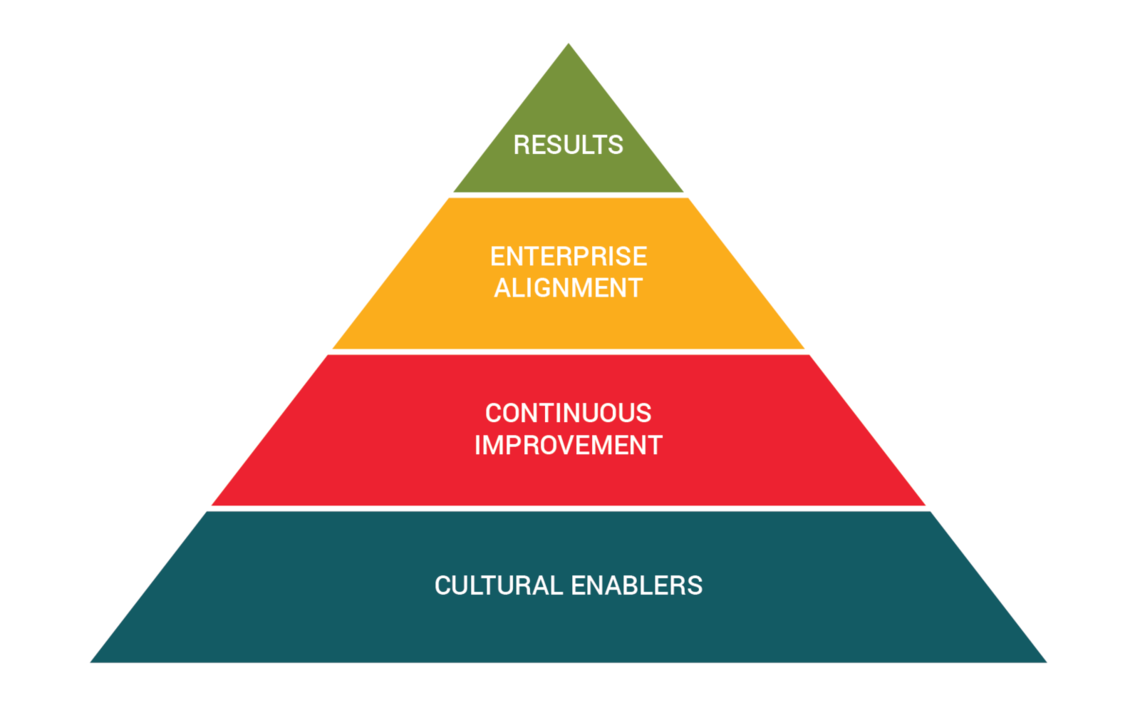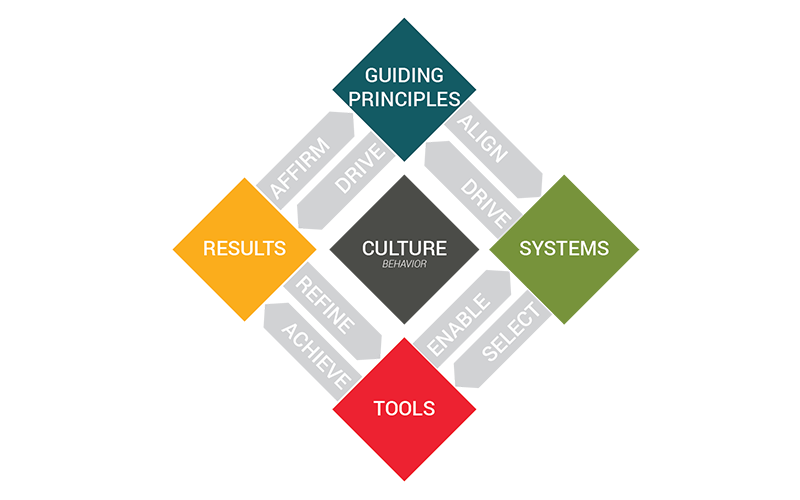Learning Objectives
After completing the lesson you will be able to:
1) Define Shingo within the health care context
2) Identify gaps in local culture for improvement
3) Implement strategies for fostering a culture of continuous improvement
Case study
Brent leads a large team of nurses, health care assistants, and scrub techs as the manager of a surgical center that supports up to 30 surgeries a day. He wants a strong team culture where the employees and physicians know the beliefs that guide their work. Brent begins by creating a manifesto that he can share with each member of the team. The manifesto is a written document that outlines the important work of the department, the values that drive the work and the professional expectations that make the team work better. He then works with his team to build patient trust by complimenting their skills and expertise in the pre-op environment. Finally, he starts a forum for shared purpose by authoring a blog on the organization’s intranet, providing a way to share feedback and ways they can improve together.
What is the Shingo Model?
he Shingo Model is a principle-based approach to changing organizational culture. It focuses on creating systems that enable continuous improvement, scaling those systems, and, once scaled, sustaining them.
Why is it useful?
Cultural factors often indicate the underlying success or failure of a change effort. A big part of culture problems is that we simply experience them—we don’t take the time to identify and clarify what our culture is. Shingo gives a frameworkShingo is named after Japanese industrial engineer Shiego Shingo (1909-1990), whose work helped inform development of the Toyota Production System (TPS)—or Lean manufacturing. Lean is an improvement method that focuses on systematically eliminating waste in every process, procedure, and task. for understanding, identifying and building a healthy team and organizational culture.
The thing that I really like about the Shingo Model is that it recognizes that each person within an organization has their own values and beliefs that drive their behavior within the organization. Those individual behaviors then drive the organization’s results. A successful organization manages culture and uses principles to guide ideal behavior. Principles are the foundational rules that govern the consequences of behaviors and provide the “why” of how we act in the organization.
How it works
The Shingo Model is based on ten guiding principles divided into four dimensions:
1. First Dimension: Cultural Enablers
There are two parts to respect, the respect that happens within an organization—how employees feel about and treat one another. And respect that happens outside of the organization—how employees treat patients, partners, and other members of the communities we live and work in. The Shingo Model focuses on respect as a way of helping individuals achieve their maximum potential. People give their all when they know they are respected. They are respected when they are treated as equal human beings.
Examples
-
Hospitals and Clinics annual assessment framework, especially the professional development section.
-
The people doing the work, improve the work.
-
Organizational development, like skills coaching.
Our culture does not always value humility. But intellectual humility, on the part of the leader and the employee, is foundational to improvement work. Like Brene Brown says, leadership requires a certain level of vulnerability so that we can discard the preconceived beliefs that prevent us from exploring unlikely solutions.
Examples
-
Leaders who stay engaged throughout the length of the project (not just at the beginning or end).
-
Psychological safety—employees don’t expect retribution when they share concerns.
2. Second Dimension: Continuous Improvement
Perfection may be an impossible goal. However, the pursuit of perfection drives us toward continuous improvement. Seeking perfection is a state of mind that refuses to be limited by the status quo.
Examples
- Seek long-term solutions not temporary fixes.
- Constantly work toward simplifying work.
Medicine is particularly suited to the principle of scientific thinking. Through rigorous experimentation, direct observation, and the reporting of results, medicine and the practice of medicine advance. This applies not only to successful endeavors, but to failures as well. Good scientific thinking learns just as much from the losses as the wins.
Examples
-
Follow a structured approach to solving problems.
-
Encourage people to learn from their failures.
The Shingo Model always focuses on processes over people. This can be tricky because our natural instinct is often to blame people when something goes wrong. But even top performers suffer in an environment with confusing or sloppy processes. Bad outcomes can almost always be traced back to faulty processes.
Examples
-
Separate people from processes, like Sarah Sherer does.
-
Make sure you have all the information by nailing down your process.
You know the line about a few bad apples? It is a bit misunderstood. The point is that even one bad apple can ruin the entire barrel. The same holds true for our improvement efforts. An error at the source will contaminate the rest of the process.
Examples
-
Organize places of work so potential problems become immediately visible.
-
Stop work to fix errors before continuing.
At its core, this principle has two elements. First, only have as many products (procedures, etc.) as the patient demands. Anything outside of that is potentially wasteful to the organization and the patient. Second, ensure you have sufficient resources to deliver the service without interruption. A lack of resources is a source of waste.
Examples
-
Avoid creating or having more product or services than are necessary to serve demand.
-
Ensure the resources that are needed are available when required.
3. Third Dimension: Enterprise Alignment
The improver should focus on their end goal, and not necessarily how to get there. Often we talk about this in terms of vision. If given a clear vision, teams will naturally do what it takes to get there—often in ways that are surprisingly more efficient or innovative than previously thought.
Examples
-
Clearly communicate the direction and purpose of the organization to all.
-
Set goals that are connected to the organization’s overall goals.
Alignment has become something of a buzzword over the last few years. At its heart, it refers to removing barriers within an organization to ensure the free flow of ideas and decisions across the system.
Examples
-
Eliminate any barrier that prevents the flow of ideas, information, decisions, product, etc.
-
Ensure the goals and issues for each day are understood by those who are affected.
4. Fourth Dimension: Results
Patients are our true north. Every improvement we make should be looked at through the lens of creating value for our patients (giving them a better experience, improving their safety and outcomes, and lowering their costs).
Examples
-
The Patient Design Studio helps employees understand the needs and expectations of our patients.
-
We embrace a team of teams improvement framework.
Why it works
When I look to organizations that use Shingo, two success factors stand out:
-
Every individual in the company is empowered to identify the problem and work to find the solution. They know how to use process improvement tools and they make their processes better by using those tools.
-
The culture praises preventing problems rather than fixing problems.
How do I start a cultural shift in my area?
The first step as a leader is to explore the Shingo principles and understand what each of them means. Once the principles are understood, start incorporating them into your area by sharing the principles with your team and using the principles to reward ideal behaviors, much like Brent does in the case study above. Then, start with the cultural enablers. Showing respect and leading with humility will provide the foundation you need to start your cultural shift.
Resources:
-
The Shingo Institute has a wealth of great resources from our colleagues at Utah State University.
-
The Culture Factor (HBR 2018) gives high-level insights on organizational culture.
-
Understanding Organizational Culture for Healthcare Quality Improvement (BMJ 2018) examines unique cultural elements that impact change in health care.
Culture is the driver: The Shingo Model
Developed by the Shingo Insitute, the Guiding Principles diamond reflects culture as central to organizational success:
*Originally published June 18, 2020
Cindy Spangler
Senior Value Engineer Luca Boi translates Lean lessons in culture building from Hollywood’s big screen to our everyday lives.
The new Master of Education in Health Professions degree program offers a unique opportunity to improve teaching skills, influence the future of clinical care, and increase the impact of clinical educators. The program’s interprofessional leaders, Joanne Rolls, Rebecca Wilson, and Wendy Hobson-Rohrer, share why the program is important and offer a few quick tips to improve your teaching today.
To disagree means failing to agree. Synonyms include to contradict, challenge or debate. Synonyms do not also have to include to argue, quarrel, dispute, bicker or clash. Pediatric intensivist Jared Henricksen shares the best path forward when words become clouded with emotion.


